7 Stupid Things You Can Do With Air
![Pulling Air From The Crawl Space To Cool The House Is A Really Stupid Thing To Do With Air [Photo Courtesy Of E3 Innovate In Nashville, TN]](https://www.energyvanguard.com/wp-content/uploads/2023/10/cool-air-intake-crawl-space-e3-innovate.jpg)
The Talking Heads said it best: “Air can hurt you, too.” And it does it in so many ways. It can hurt your pocketbook. It can make you uncomfortable. It can make you sweat. It can make you sick. And, if you believe the Talking Heads, “it can break your heart.” So let’s look at a few of the stupid things you can do with air to make it hurt you.
1. Using crawl space air to cool the house
My friends at E3 Innovate in Nashville have encountered many stupid things done with air, and this one is a classic. In one of the homes they improved, they found that someone had rigged up a fan with some ductwork in an attempt to cool the house.
I wrote an article about this “innovation” in 2016. The biggest problem here is indoor air quality. A vented crawl space in the Southeast is often the nastiest part of a house. And in this case, there was something to make it especially nasty. (Read the article to find out.)
Yeah, they did put a filter on that intake, but that’s far from enough to make that air worth bringing into the house. The other big problem is that along with that slightly cooler air, you’re bringing a lot of humidity into the house.
Definitely not worth it!
2. Using attic air to ventilate the house
In a similar vain, someone in Atlanta decided to use air from a dirty, vented attic to ventilate their home. (I hear this is fairly common in Australia and New Zealand, too.) The photo below shows how they did it.
![A hole in the return plenum pulls in air from a vented attic for "fresh air" [Photo courtesy of Bruce Kitchell]](https://www.energyvanguard.com/wp-content/uploads/2016/11/filter-over-plenum-hole-ventilation-air-intake.jpg)
Again, really stupid idea. What are the problems?
- Super hot air getting pulled into the system in summer, possibly overwhelming the cooling capacity of the air conditioner
- Bypass around the filter
- An inefficient filter in this case
Read the article I wrote on this for more.
3. Venting dryer exhaust into the house
In theory, this is a nice idea. Your home needs heat (and maybe humidity) in winter, so why send all that dryer exhaust to the outdoors, right? I stayed in a rental condo in North Carolina recently where they had done this. Here’s what it looked like.
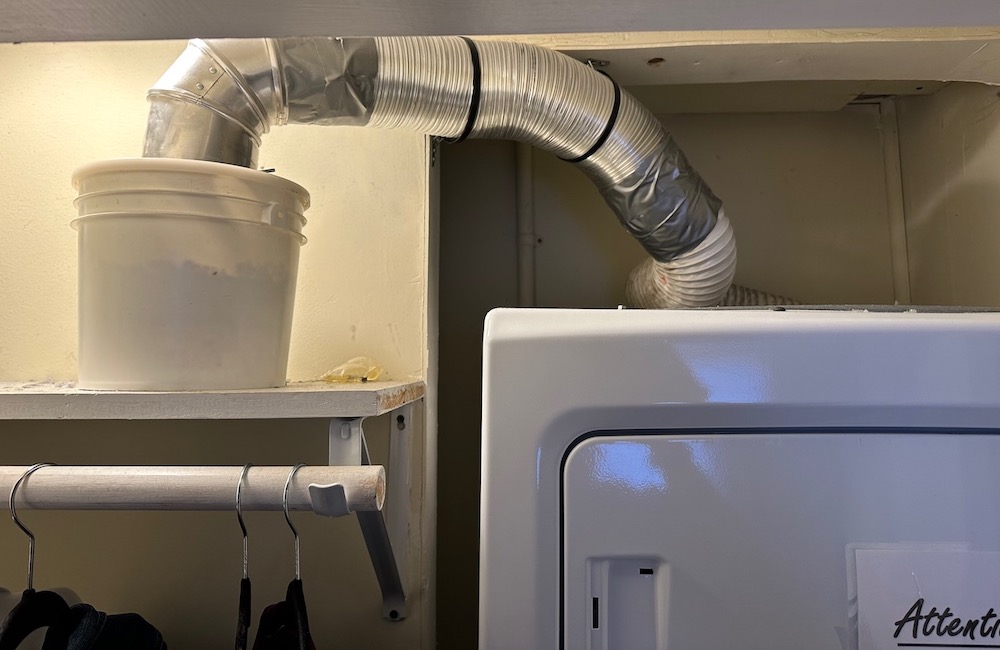
And of course, you’re wondering what the bucket looks like so I got that photo, too.
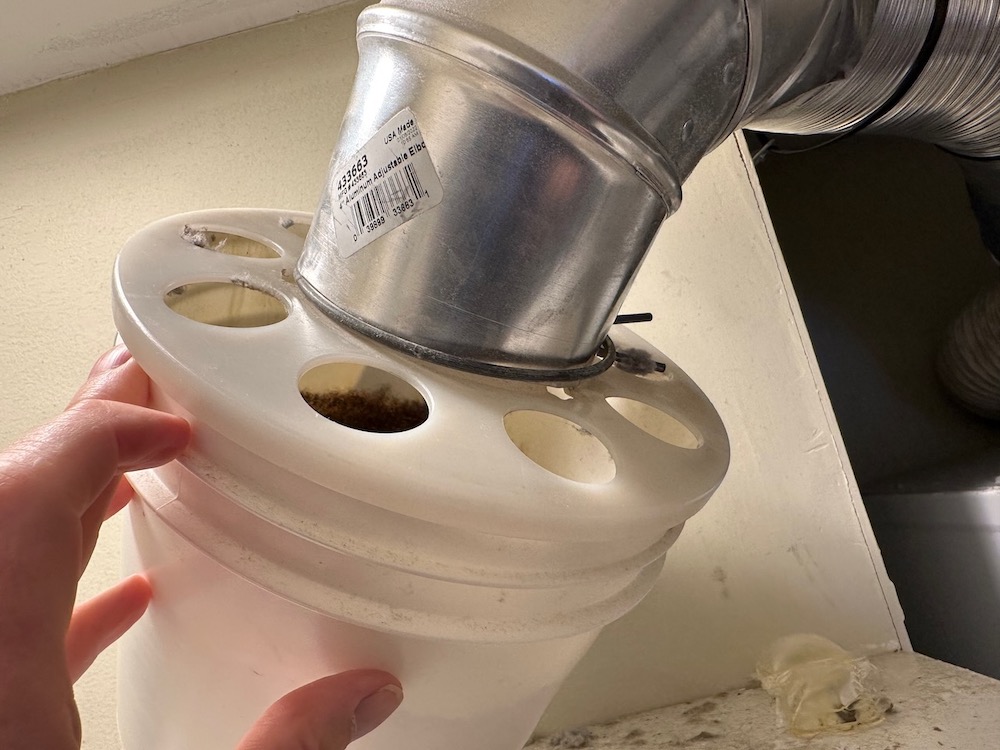
Here are a few problems.
- YOU SHOULD NEVER EXHAUST A GAS DRYER TO THE INDOORS. I don’t do all-caps very often, but this point deserves extra emphasis. The combustion gases for a gas dryer go out the same vent as the warm humid air, so you don’t want to send all those pollutants to the indoors. (Our rental condo had an electric dryer.)
- With no filtration, a lot of lint gets out into the laundry room and beyond.
- With filtration, you may be putting the dryer vent under too much pressure to keep the air flow up. Low air flow can cause the dryer to run longer.
- Low air flow and lint buildup in the dryer vent can cause a fire.
- In this condo, there was no alternate venting route. That room can get too warm when you run the dryer in summer.
Yeah, you can buy products online that let you send that dryer exhaust indoors. Yeah, engineers and other technical types sometimes rig up their own systems. And yeah, if you’re careful and diligent in your maintenance, this can put heat and humidity back into your home’s air. Engineer David Schurk did it at his house and said about it: “I didn’t feel the juice was worth the squeeze, and I was having to clean the filter every few days, so after one winter season I abandoned it.”
So this isn’t a completely stupid thing to do with air, but you gotta know what you’re doing. Check out the comments on my LinkedIn post on this topic for more.
4. Venting the refrigerator to the attic
When I was working on my in-laws’ house 15 years ago, I found a dark spot in the insulation when I was crawling around the attic. When I pulled it back, I found a hole that was about two thirds of a square foot (0.06 m2). The photo below shows only about half of it, with another hole on the other side of the joist.
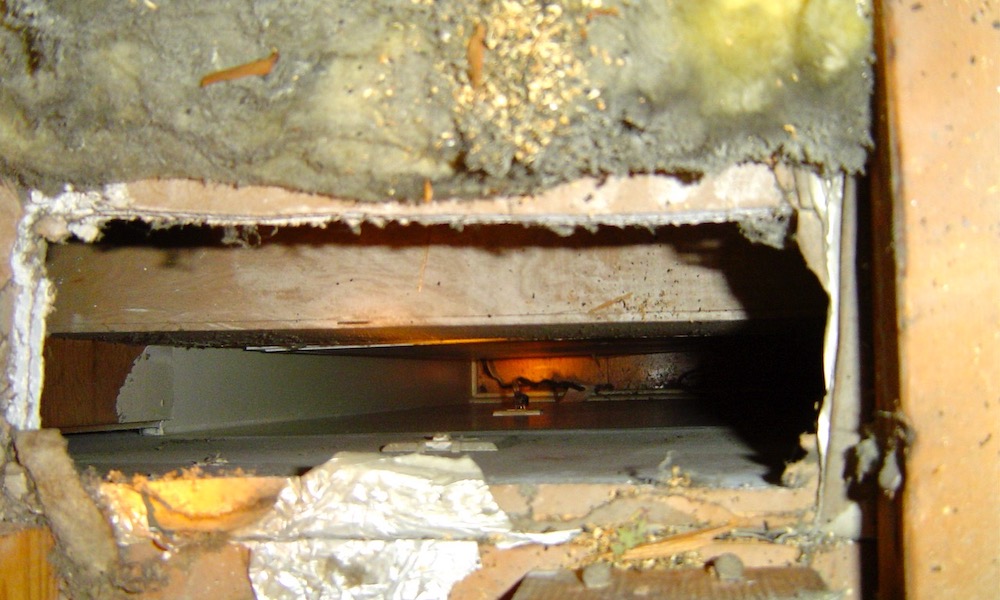
Peering down into the hole, I saw a cord plugged into the wall and realized I was looking at the back of the refrigerator. So not only did this hole in the ceiling allow a lot of warm air from the house to leak into the attic, but it got an assist with the extra heat from the fridge. That caused it to leak more than if it were in another part of the ceiling.
Just don’t.
5. Dehumidifying a vented crawl space (or basement)
A dehumidifier is a handy piece of equipment to have when you need one. But giving it a Herculean task is silly. I’ve been in a number of vented crawl spaces and basements where a dehumidifier valiantly tries to dehumidify that space. That photo below shows one of them.
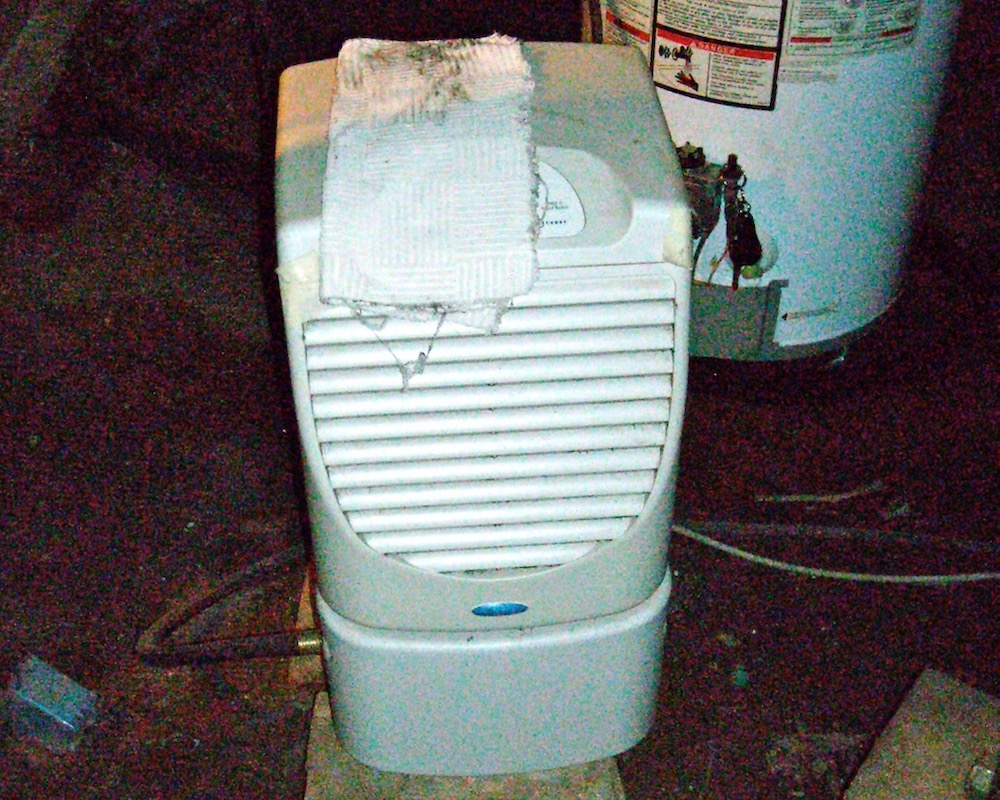
As I’ve said before, you can’t dehumidify your whole neighborhood or city. And yet people keep trying to this stupid thing with the air. More here.
6. Conditioning your garage with the home’s ducted system
Another really stupid thing to do with air that can make you sick is to put a supply vent (or two or three) from your main heating and cooling system in the garage. You’d never put a return vent in the garage because you don’t want to suck that polluted air in and distribute it to the house, right?
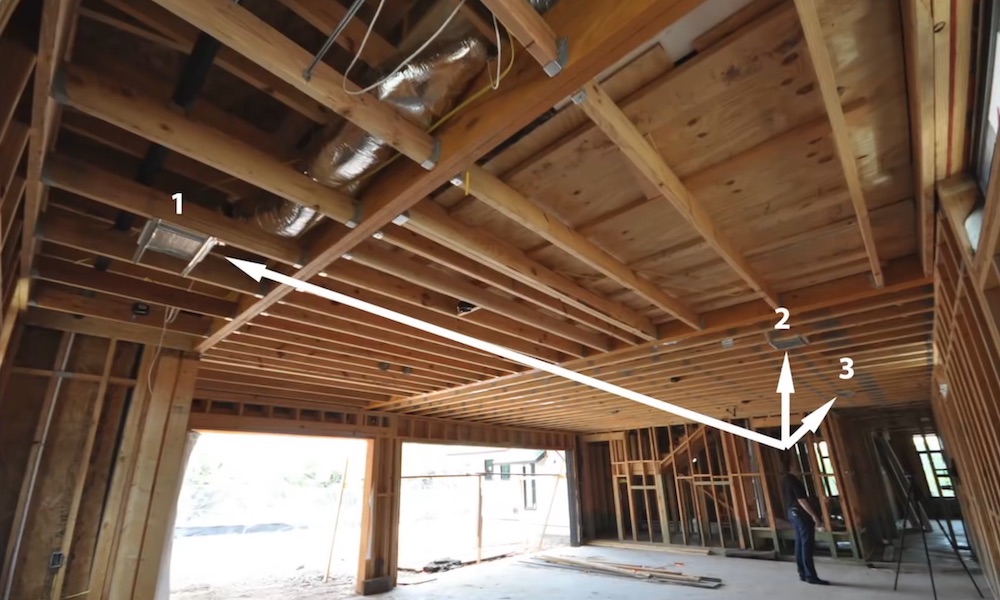
As it turns out, putting a supply vent in the garage has pretty much the same effect as putting a return vent there. Why? Because when you pressurize the garage with supply air, you depressurize the house. That pressure difference sends polluted garage air into the house.
See my article on that topic, which includes an early Matt Risinger video.
7. Letting duct leakage and filter bypass ruin your indoor air quality
Duct leakage and filter bypass allow all kinds of dust and pollutants (like skin flakes) to go through your duct system. Some of those pollutants will go right through ducts and air handler and be distributed into your indoor air. If all your ducts are in conditioned space, there’s no net gain of indoor pollutants, right?
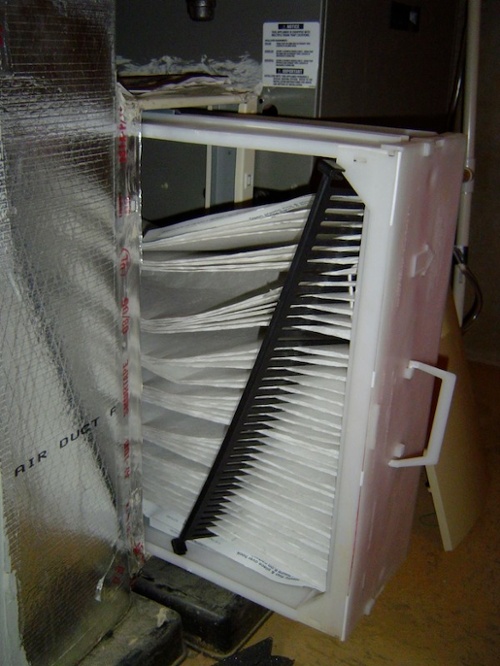
Probably not. When the coil is wet, that junk sticks to it. You can get nasty microbial growth on the coil and in the drain pan. That stuff can get into your indoor air, compounding the indoor air quality problem. Plus, it diminishes your system efficiency and durability, costing you more money.
To make things even worse, put your ducts in a nasty crawl space, polluted garage, or dirty attic.
Don’t do stupid things
It would be disrespectful of me to end this article on stupid things you can do with air and not mention the master of stupid things. Yes, I’m talking about Joseph Lstiburek, PhD, PE. He’s made a career of brilliantly pointing out how most of our problems with buildings result from doing stupid things. If you don’t already, you should subscribe to his newsletter and read his articles religiously if you want to understand building science.
But stupid things aren’t all he writes about. Sometimes he writes about dumb things, as he did in Top Ten Dumb Things To Do In the South.
Now, back to the topic of the day here. Are you doing stupid things with the air in your house? If so, you may be singing those Talking Heads lines:
What is happening to my skin?Where is that protection that I needed?Air can hurt you tooAir can hurt you too
So my advice is to listen to Dr. Joe: Don’t do stupid things!
Allison A. Bailes III, PhD is a speaker, writer, building science consultant, and the founder of Energy Vanguard in Decatur, Georgia. He has a doctorate in physics and is the author of a bestselling book on building science. He also writes the Energy Vanguard Blog. For more updates, you can subscribe to Energy Vanguard’s weekly newsletter and follow him on LinkedIn.
Related Articles
Can You Cool Your Home with Crawl Space Air?
Can You Ventilate a Home with Attic Air?
4 Ways a Bad Duct System Can Lead to Poor Indoor Air Quality
Comments are welcome and moderated. Your comment will appear below after approval.
This Post Has 15 Comments
Comments are closed.

How about a 95 pint per day dehumidifier, in a ventilated attic, in HOUSTON!!! SMH
Yeah, that definitely qualifies under the trying to dehumidify the whole outdoors rule.
Crawl space is a great spot to get radon gas!
I would love to have a commercial fridge with the condenser outside the house. It’s amazing how much heat a fridge adds to the cooling load of a house.
And why do we still not have sealed dryers with a fresh air intake to them instead of taking expensive conditioned air out of the house.
Robert: Refrigerators definitely do add heat, but it may not be as much as you think. Current models typically use ~500 kWh of electricity per year. Let’s round up to 600 kWh/yr, which is 50 kWh/month. Since it takes 3,412 BTU to make a kWh, that’s ~171,000 BTU. There are 720 hours in a 30 day month, so that makes the average cooling load from the fridge equal to less than 240 BTU/hr. At 12,000 BTU/hr to the ton, a fridge adds about 0.02 ton of cooling. That’s not even enough to change the size of AC or heat pump you install.
You are forgetting that a refrigerator is a heat pump and has a COP of more than 1. It is pulling heat out of the refrigerator and dumping it into the room. the heat from the house is working it’s way into the fridge but the fridge is working harder to pull it out faster than it comes in. And in climates like ours here in Crematoria (TX) fridges work harder and run longer in the summer because most houses are not kept at 72*. Any heat you can get out of the house is a benefit.
That said what is far worse is the better halfs computer rig. Her office is hot year round as the PC and monitors etc are like running space heaters in there. I have yet to design an outdoor cooling box to put her tower in or find a way to put it down in the crawlspace. When I move her office to a larger room it will probably get a minisplit. And lets not talk about is the door open as no it isn’t and no it can’t be.
Allison, wouldn’t that 600 kWh/yr represent just the energy to run the compressor, fan and lights and not the energy being moved from the food (and water, if there is an ice maker) to the conditioned space? While it isn’t going to make it a huge load, with a COP of 4, the fridge would be adding more like 1000 BTU/hr to the load of the house.
We seem to be having some misunderstanding about refrigerator thermodynamics. It is true that the heat rejected by the condenser is greater than the electrical input. However, there is also heat being conducted from the room to the inside of the refrigerator and this helps cool the house. Conservation of energy tells us that over a long period of time, the energy entering the refrigerator (electrical and heat conduction from the space) equals the energy leaving the refrigerator (from the condenser). Thus, the net heat load on the room is just the electrical consumption. This ignores some other additional loads like putting hot food in the refrigerator and removing ice from it, but those are usually relatively small.
In terms of putting the condenser outside, this would help decrease electrical consumption in the winter, but increase electrical consumption in the summer. The net impact on overall home energy consumption would depend on the space heating/cooling system characteristics. The refrigerator with an external condenser would also be a much more expensive piece of equipment due to the additional complexity needed to operate over a much wider range of external conditions.
RoyC: Thanks for setting us straight. You’re the best thermodynamicist I know! Of course the heat flows equal out over a long enough time scale so my first calculation was correct. The heat moved out through the condensing coil equals the heat that moved into the fridge over time, as you stated.
Always fun reading your blog. I can’t count how many homeowners or remodelers have called me to add ductwork for the garage. The only pro I can see by doing this is that maybe the head system will benefit mechanically from having adequate airflow. Still not worth it with all the cons. Fun easy read. Thanks
Ross: Definitely not worth it if you’re using the same system serving the house. We’ve done plenty of HVAC designs with conditioned garages but always with a ductless unit.
Allison, I need a little bit of encouragement. I used to be like you, endlessly optimistic, which is a great state of mind to have. Lately, I’ve been tempted by the dark side over and over again to give up trying to convince people about the merits of BS (for those tempted to laugh: building science, although the other BS may have its own merits).
When well educated, respected members of the community admit on social media that, for example, having a supply register in the garage is nothing to worry about, absolutely nothing, well, then I just give up. Explaining BS then becomes like the story of Sisyphus in the Greek mythology: endless.
Another reason to exclude the attached garage from a ducted system is that when the air handler is off each register becomes an opening for infiltration. On a cold night or hot afternoon contaminants now have a hole and a pressure difference for air movement thanks to the stack effect.
And about venting that damn refrigerator, is it ever worth it after considering the temperature and humidity of the makeup air?
I am not sure if I want to admit it, but I used to vent my electric dryer to the indoors during the winter when I lived in upstate New York. We had a large laundry room on the second floor and would leave the door open to be sure that we distributed the humidity throughout the house. We used the same bucket termination that you show in the photo above. You did not mention that you are supposed to put water in the bucket to help catch the lint. After 5 winters in NY, we never felt that we had any lint problems in the house. This arrangement probably helped to keep the outdoor venting cleaner since it was only used during the summer and should months. The pressure drop through the bucket “filter” is probably lower than through the external venting arrangement.
But don’t even think about doing this with a gas dryer!
An honourable mention might be installing high velocity ‘slot’ type supply air diffusers without 10′ of a range hood. It efficiently reduces hood performance to zero.
https://drive.google.com/file/d/1bd5Y1UjT6-sgpz1M_pVYwyXafneIiOzg/view?usp=sharing